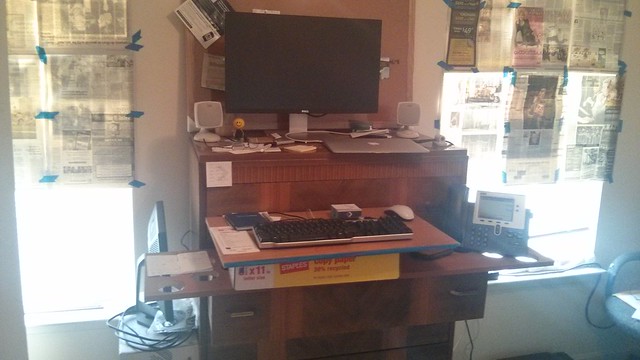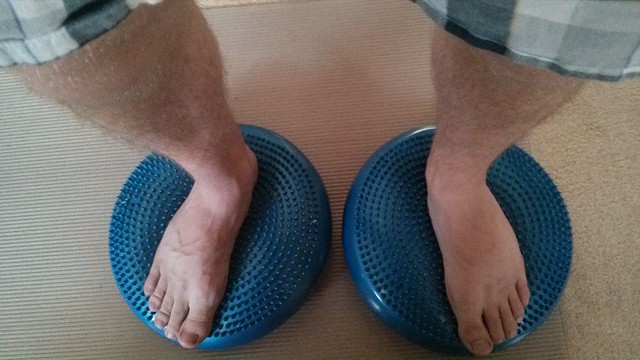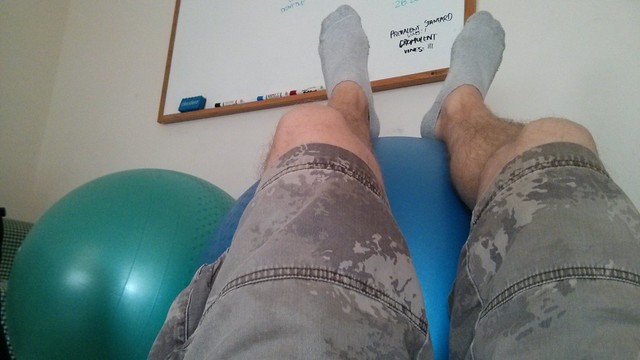My Home Office
I’m a remote employee at Cloudera. No matter what my business card says or what address I provide when registering for an event, I’m not assigned to any of our offices. I don’t have designated space at any of them, nor do I visit often. When I do work from one of our offices, I sit whenever there’s a free chair or standing desk.
When I started at Cloudera, I had to set up my home office. There’s no right way to do this, what works for some people doesn’t work for others, both functionally and aesthetically. Working from home has been an ongoing life experiment and over time my home setup has changed incrementally in response to my workflow. Some things worked, others didn’t.
Here’s my current setup.
ℹ️ As an Amazon Associate I earn from qualifying purchases. (details)
Physical Constraints
My home office occupies a spare bedroom in my home. It’s a good sized 10x14 room, not enormous, but certainly larger than a typical office cube. Two windows provide ample natural light.
The closet contains my vast collection of corporate “apparel” t-shirts and hoodies, computer equipment, and other company-purchased items like the coffeemaker we use for coworking sessions.
Most importantly, it’s a dedicated space. I don’t use it for anything personal. It’s for work. Period.
Standing Desk
I’m a big fan of the standing desk.
Standing desks come in all shapes, sizes, and prices. Some just put their desks up on blocks, others go for a more architecturally pleasing but permanent option, some just go straight to Amazon and buy something fancy and heavy from Vari-desk, and some just ask their employer to provide something and hope for the best.
When I started working from home I started out with a typical sitting desk. I wasn’t sure if I was going to like the standing desk or not, so I cobbled one together with what I had on-hand rather than purchasing something new.
My standing desk is composed of drawers, the top from a box of photocopy paper, and a cheap laminated MDF shelving board. The drawers were left to me by a former roommate, the box top came off the box that I packed up from my last job (which oddly enough sits in the closet some years later, untouched), and the MDF was left over from some custom beer pong experiment gone horribly wrong.
As drawers, they're lovely. As a desk, they're hideous. But who cares? This configuration cost nothing, is the right height, keeps me moving around, and is counterbalanced by all the running gear that I ought to be wearing throughout the year. Everything in its place.
Who Needs a Chair?
Sitting in a chair at a desk in a cube farm for the better part of a decade wasn't too good on my body.
I love my standing desk, but just as we weren't meant to sit in a chair for eight hours a day we weren't meant to stand in place all day either. I started with a simple anti-fatigue mat and found it helped my feet. There’s a reason they are a ubiquitous fixture in restaurants, bars, garages, and kitchens worldwide: they work. I think they’re more useful for task-driven workers, less so someone who stays in the same place for a long period of time.
Today, I use a combination of products to combat fatigue, vary my posture, and enable movement throughout the day:
- Airex Balance Pad - A little more expensive than the other products, but well worth it. These pads are springy but firm, retain their shape, and provide slight instability. The regular model is smooth but not slippery and provides enough room for both feet to rest comfortably shoulder-width apart.
- Gaiam Balance Balls - Blue (75cm) and Green (65m) - Air-filled and very firm, perfect for sitting, bouncing, and countless other exercises.
- Air Stability Wobble Cushion - These air-filled wobble cushions are, well, wobbly. Whether you stand on one cushion with both feet, one foot on and one off, or one foot on each cushion, your weight is constantly shifting around, especially if you bounce around while listening to music. I also like the foot massage that the spikes provide.
- the boxes everything came in
I spend most of my time standing, split between the Airex pad and a pair of wobble cushions. Both were recommended by my chiropractor for doing stretches and strengthening my spine, but they quickly found their way into my office. In addition to helping with fatigue, both devices encourage motion. I take phone calls and watch WebEx events seated on a balance ball. In any case, I’m usually in motion.
I change my position every hour or so, sometimes to new equipment and sometimes just how I’m using it. I might change from two wobble cushions to one wobble cushion and one foot elevated up on a box; the next hour I may just switch which foot is elevated. Or I might have one foot on the wobble cushion and the other on the Airex. There’s no magic formula other than variety.
Whiteboard
Twelve square feet of dry erase space.
Quick notes, phone numbers, conference call PINs. You name it, it's on there. You can always tell a planning session, the 10x14 room will reek of dry erase marker ink for hours. Surely it's non-toxic, right?
The Bare Wall
While the whiteboard is good for quick things, I'm a big fan of a bare wall for project planning. Colored sticky notes can be easily rearranged on the wall, perfect for keeping tabs on that business trip that keeps moving around. When a sticky note is too small, there's blue painter's tape to affix larger pieces of paper.
A Real Phone
A phone with a quality speaker and physical mute button is an absolute must when you work from home. I like the venerable and very-unsupported Cisco 7940, since succeeded by the 7942G back in 2009.
Why does this matter?
- AUDIO QUALITY. You'll quickly tire of listening to conference calls on your cell phone or computer speakers. The size of your cell phone’s earpiece and speaker drivers are just too small to sound good. You could wear headphones, but wearing headphones in your own home kinda defeats the purpose. The same goes for computer speakers, plus you never know when that Adobe Flash update will restart your browser without warning, killing your call in progress.
- HARDWARE MUTE. I want a physical button to push and visual confirmation. Do you really want to trust the software mute on your conference call? the one that the leader or host can override? I don't.
A slight rant follows.
For the sake of humanity, really. Everyone hates hearing dozens of unmuted cell phones on conference calls, slightly less than hearing the kids screaming in the background thanks to some idle participant who can’t figure out how to mute their phone. Don't contribute to the problem and maybe good karma will come around.
It doesn't even matter if the phone is a connected to a landline, a nifty little OBi100 voice bridge rigged up to your Google Voice account, some VOiP phone that plugs into your corporate network, or a full blown Asterix PBX with all the bells and whistles... better audio and physical mute button.
That is all.
Last Modified: 2020-08-09
§
Home | All Entries | Search | Errata
Copyright © 2014-2024 Alex Moundalexis, licensed under a Creative Commons License. Some rights reserved.


